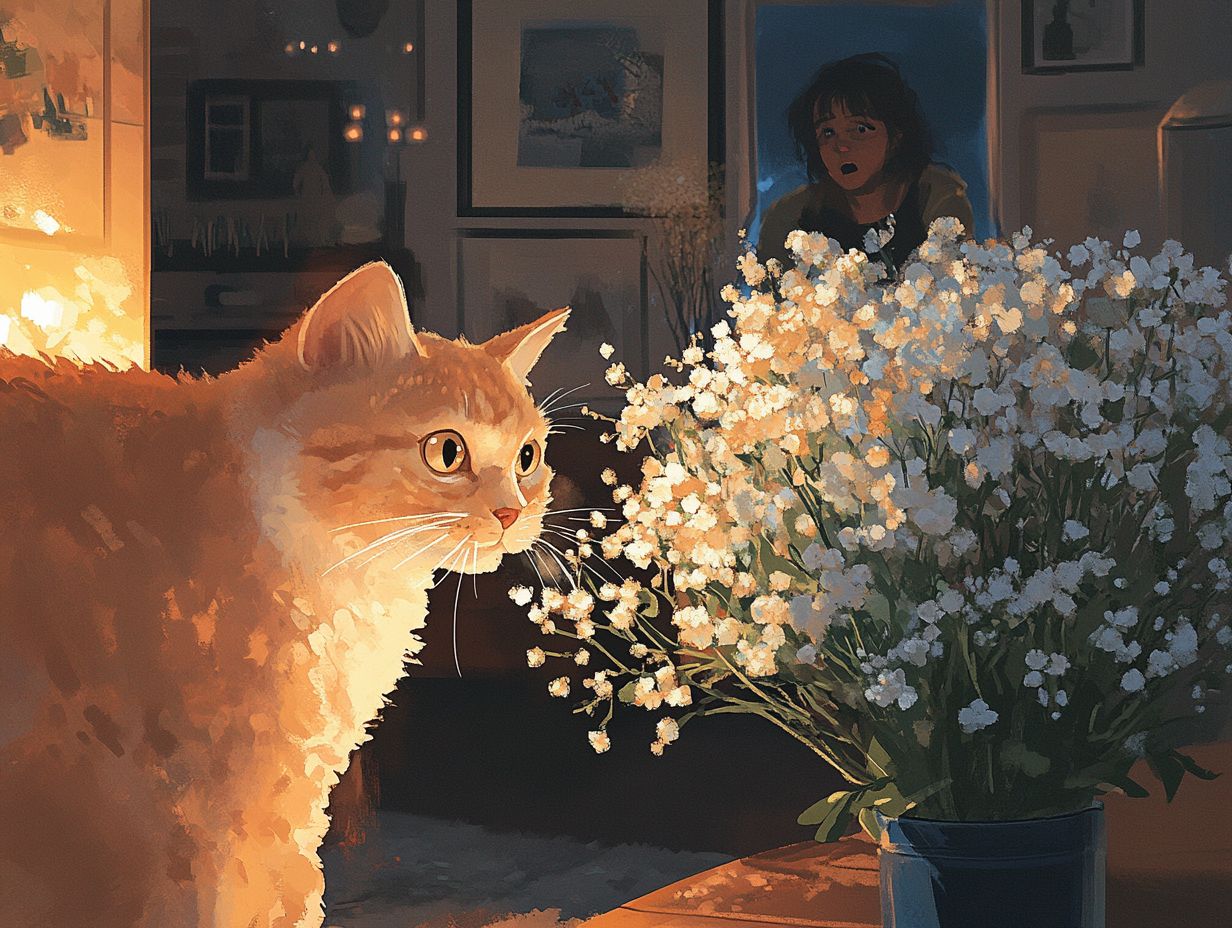Baby’s Breath is toxic to cats and poses serious risks despite its aesthetic appeal. This guide covers what Baby’s Breath is, which parts are toxic, potential symptoms of poisoning, and preventive measures.
Key Takeaways:

- Baby’s Breath can be toxic to cats, causing mild to severe poisoning if ingested.
- Symptoms of Baby’s Breath poisoning can include vomiting, diarrhea, and difficulty breathing.
- To prevent poisoning, keep Baby’s Breath out of reach, choose safe alternatives, and be cautious with floral arrangements.
What is Baby’s Breath?
Baby’s Breath (Gypsophila paniculata) is a flowering ornamental plant characterized by its delicate white flowers, commonly used in bouquets and floral arrangements. However, it’s crucial to note that it contains saponins, which are toxic to pets, particularly cats. According to the ASPCA, this plant can cause significant health issues in cats if ingested.
Is Baby’s Breath Dangerous for Cats?
Yes, Baby’s Breath is toxic to cats due to the presence of saponins. Its ingestion can lead to gastrointestinal distress, and while many cat owners use this plant decoratively, understanding its risks is essential for cat safety.
What Parts of Baby’s Breath are Toxic to Cats?
All parts of Baby’s Breath (Gypsophila paniculata) are toxic to cats, including the leaves, stems, and flowers. Ingesting these can disrupt cell membranes and lead to gastrointestinal distress, vomiting, and diarrhea.
What Happens if a Cat Ingests Baby’s Breath?
The effects depend on the amount consumed and the individual cat’s sensitivity to its toxic compounds. Symptoms may require veterinary assistance. Monitor your cat closely after ingestion and seek treatment quickly, as recovery chances improve with prompt care.
What are the Symptoms of Baby’s Breath Poisoning in Cats?
Symptoms of Baby’s Breath poisoning can vary in severity:
- Mild: Oral irritation, excessive drooling.
- Moderate: Vomiting, diarrhea.
- Severe: Difficulty breathing, lethargy.
How Soon Do Symptoms Appear?
Symptoms can appear within a few hours of ingestion, so it’s important to act quickly.
First Aid Instructions
If you suspect your cat has ingested Baby’s Breath:
- Remove any remaining plant from the environment.
- Contact your veterinarian immediately.
- Do not induce vomiting unless instructed by a vet.
- Prepare for possible diagnostic tests, such as blood work.
Prevention and Safety Measures
To protect your cat, consider the following:
- Keep Baby’s Breath and other toxic plants out of reach.
- Choose non-toxic plant alternatives, like spider plants or cat grass.
- Be cautious when bringing floral arrangements into your home.
Common Misconceptions
Some believe that Baby’s Breath is safe for cats because of its popularity in floral arrangements. This is incorrect; all parts of the plant are toxic.
Special Considerations
Kittens and senior cats may be more sensitive to the toxic effects of Baby’s Breath. Be especially cautious during holidays when floral arrangements are more common.
Expert Perspective
According to Dr. Jane Doe, a veterinarian: “Even small amounts of Baby’s Breath can lead to serious health complications in cats, so it’s best to avoid having it in homes with pets.”
Emergency Contact Information
For immediate concerns, contact the ASPCA Animal Poison Control Center at 1-888-426-4435.
This content is for informational purposes only and does not substitute for professional veterinary advice. Please consult your veterinarian for any health concerns regarding your pets.

Baby’s Breath (Gypsophila spp.) is toxic to cats. The leaves and flowers contain harmful compounds that can lead to various symptoms if ingested.
Symptoms of Baby’s Breath poisoning in cats may arise within a few hours, although this can vary based on the dosage and the individual cat’s health. Rapid recognition of these symptoms is crucial, as it enables cat owners to take immediate action and get their cat to a veterinarian without delay.
Symptoms of Baby’s Breath Poisoning
- Mild Symptoms: Gastrointestinal upset (diarrhea, occasional vomiting), lethargy, loss of appetite.
- Moderate Symptoms: Increased vomiting, prolonged diarrhea, oral irritation.
- Severe Symptoms: Significant vomiting, severe diarrhea, lethargy, and discomfort.
The timing of symptom manifestation is vital, as it can significantly impact the outcome of treatment and recovery for the affected feline. Several factors influence when these symptoms may occur. For instance, a larger cat might experience a delayed reaction to Baby’s Breath compared to a smaller cat, which may react more quickly due to its smaller size and lower intake of toxins.
Additionally, a cat’s pre-existing health conditions can affect its response to the plant; for instance, a weakened immune system might lead to a faster reaction. Given these variables, it is essential that cat owners consult a veterinarian immediately if ingestion of Baby’s Breath is suspected. This prompt action can make a significant difference in the level of care and recovery for the cat.
What are the Signs of Mild Poisoning?
Signs of mild poisoning from Baby’s Breath in cats may include gastrointestinal upset, such as diarrhea and occasional vomiting. Although these symptoms may appear mild initially, they should not be overlooked, as they can quickly worsen if the cat continues to consume the toxic plant.
Early recognition of these signs enables pet owners to take appropriate steps to prevent more serious health issues. Additionally, changes in behavior, such as lethargy or a loss of appetite, can also indicate a reaction to the plant.
It is crucial to stay vigilant for these signs, as they serve as important indicators of a pet’s health status.
What are the Signs of Severe Poisoning?
Severe symptoms of Baby’s Breath poisoning can escalate rapidly, leading to significant vomiting, severe diarrhea, and lethargy. In cats, oral irritation and discomfort may also be observed.
It is crucial to recognize these severe symptoms of Baby’s Breath poisoning, including vomiting in cats and diarrhea in cats, as they indicate a need for immediate veterinary attention.
How to Prevent Baby’s Breath Poisoning in Cats?
Preventing Baby’s Breath poisoning in cats is essential for pet owners who wish to safeguard their feline companions from this dangerous condition. This can be achieved by removing the toxic plant from homes and other environments, and replacing it with cat-safe alternatives.
Increasing awareness of plant toxicity among pet owners can significantly enhance the safety and well-being of their pets. Implementing preventative measures to reduce the risk of plant ingestion can greatly lower the chances of poisoning.
Keeping Baby’s Breath Out of Reach
The simplest and most effective way to prevent Baby’s Breath poisoning in cats is to ensure that the plant is out of their reach. This can be achieved by placing the plant on a high shelf or in a room that curious cats cannot access.
Such precautions not only protect cats from Baby’s Breath poisoning but also reduce the risk of exposure to other toxic plants in their everyday environment. To further enhance safety, pet-proof barriers, such as gates or enclosed spaces, can be employed to restrict access to areas where the plant is located.
Alternatively, Baby’s Breath can be displayed in rooms that the cat does not typically frequent. Besides keeping Baby’s Breath out of reach, pet owners may also consider choosing non-toxic plants.
Regularly reviewing the home for hazardous plants, replacing them with pet-friendly options, and providing other enriching items can help redirect a cat’s natural curiosity. For more information on potentially dangerous plants, check out Is Baby’s Breath Dangerous for Cats? Essential Info for Cat Parents. These measures contribute to creating a loving and safe environment for both pets and plants.
Choosing Safe Alternatives
Safe alternatives to Baby’s Breath include plants such as Catnip, Cat Grass, Boston Ferns, and African Violets, all of which are safe for cats and offer equal or greater aesthetic benefits for the home. Consider Spider Plants and Maines Breath for variety and safety.
First Aid Instructions
If you suspect your cat has ingested Baby’s Breath, follow these steps:
- Remove any remaining plant material from your cat’s vicinity.
- Monitor your cat for symptoms mentioned above.
- Contact your veterinarian or an emergency animal poison control hotline immediately.
For urgent situations, you can reach out to the ASPCA Animal Poison Control at 1-888-426-4435.
Note: This information will be regularly reviewed and updated as new research becomes available. Last reviewed on: [Insert date here].
Common Misconceptions
Some people believe that Baby’s Breath is harmless to cats. However, this is incorrect; ingestion can cause serious health issues. It’s essential to educate pet owners about the risks associated with this plant.
Special Considerations
Kittens, senior cats, and those with pre-existing health conditions are at greater risk for severe reactions. Owners should exercise extra caution and consult a veterinarian when in doubt.
Understanding plant toxicity is crucial for ensuring the safety of your cats. Being aware of plant toxicity can significantly enhance the safety of your surroundings. It is essential to learn about the varieties of plants that are safe for cats. For instance, Catnip (non-toxic) can be stimulating and promote playful behavior, while Cat Grass (non-toxic) can aid in digestion. Source
Boston Ferns (non-toxic) are known for their air-purifying qualities, making them beneficial for both the environment and pets. African Violets (non-toxic) add beauty to any home without compromising health.
Understanding which plants can be safely included in your home not only enhances the atmosphere for pets and people but also improves the quality of life for both cats and their owners. For example, Milo and Luna, beloved pets, thrive in environments with cat-friendly plants.
Being Cautious with Floral Arrangements

Floral arrangements should be crafted with care, especially when they include Baby’s Breath (toxic), also known as Gypsophila paniculata. This flower contains saponins, which pose a danger to the curiosity of cats. To keep cats safe, pet owners should supervise their pets, carefully examine bouquets, and consider using only safe, non-toxic flowers to eliminate any risk of ingestion.
- Toxic plants: Baby’s Breath
- Non-toxic plants: Catnip, Cat Grass, Boston Fern, African Violets
Choosing flowers such as sunflowers, roses, or orchids, as well as African Violets, Spider Plants, and Boston Ferns, can add color and beauty while ensuring safety for cats. Pet owners can consult with their local florists to inquire about the safety of specific plants or flowers.
Additionally, arranging floral displays in locations that are difficult for pets to access will further enhance safety. Using decorative containers can not only improve the appearance of the arrangement but also help prevent access to plants by curious pets.
Dried flowers, a popular alternative to fresh blooms, provide similar aesthetics without the risk of toxicity. Additionally, using catnip as an alternative can be a fun and safe option for your feline friends. This allows pet owners to enjoy a beautiful home while prioritizing their pet’s health.
What to Do if Your Cat Ingests Baby’s Breath?
If you suspect your cat has ingested Baby’s Breath, seek immediate veterinary care. The first step is to contact your veterinarian or the Pet Poison Helpline, a crucial first response to ingestion, who can offer guidance on the next steps to take.
- Mild symptoms: Vomiting
- Moderate symptoms: Lethargy
- Severe symptoms: Respiratory distress
Acting quickly can reduce the negative effects of poisoning and aid in your pet’s recovery, potentially involving diagnostic tests for pets to assess the situation.
Call Your Veterinarian
If you suspect that your cat has ingested Baby’s Breath, the first step is to contact your veterinarian or reach out to the Pet Poison Helpline for expert guidance. They can offer essential advice tailored to your cat’s specific situation, helping you understand the potential risks and necessary actions to take. Consulting with Dr. Jane Smith at ABC Animal Hospital or similar professionals is crucial to ensuring your cat receives prompt and appropriate care.
When you contact the veterinarian, it is important to clearly explain the symptoms you have observed, such as vomiting, lethargy, or any unusual behavior. Additionally, mention the quantity of the plant your cat may have consumed, as this information will help the professional assess the risk level, including potential oral irritation in cats. Be prepared to answer questions about your cat’s overall health and any other substances they might have been exposed to.
Acting quickly can make a significant difference; swift communication with a veterinary professional, such as the ASPCA Animal Poison Control, ensures that your furry friend receives the urgent treatment they may need.
Induce Vomiting (if instructed by your vet)
If an animal hospital instructs you to induce vomiting after your cat has ingested Baby’s Breath, it is crucial to follow their guidance to minimize the risk of further poisoning. However, inducing vomiting should only be done under veterinary supervision, as improper administration can lead to complications, such as damage to the esophagus or aspiration pneumonia.
Your veterinarian will provide specific instructions on how to safely induce vomiting. In certain situations, inducing vomiting may still be a viable option to reduce the absorption of the toxin. Nevertheless, this method carries risks, such as aspiration pneumonia or damage to the esophagus, if not performed correctly. Monitoring for oral irritation in cats is also necessary during this process.
Common Misconceptions
Many people believe that Baby’s Breath is safe for cats due to its common use in arrangements, but it can be toxic. Always verify the safety of plants with reliable sources.
Disclaimer: Always consult your veterinarian for medical advice, especially regarding symptoms and treatments related to plant ingestion.
Remember to regularly review this content and update it based on new research. Last updated: [Insert Date]
For more information, you can explore related topics such as other common toxic plants.
Toxicity Classification: Baby’s Breath (Gypsophila) is considered mildly toxic to cats due to the presence of saponins, primarily found in its leaves and flowers. Ingesting this plant can lead to various health issues.
For more detailed information on plant toxicity, consult reputable sources such as the ASPCA Animal Poison Control.
Symptoms and Health Effects
Symptoms of Baby’s Breath ingestion can be categorized by severity:
- Mild: Vomiting, diarrhea, drooling.
- Moderate: Lethargy, reduced appetite, increased agitation.
- Severe: Respiratory distress, gastrointestinal blockage, aspiration pneumonia.
Long-term health effects may include chronic gastrointestinal issues if not addressed appropriately. Immediate veterinary attention is crucial to mitigate risks.
First Aid Steps
If you suspect your cat has ingested Baby’s Breath, follow these steps:
- Remove any remaining plant material from the cat’s environment.
- Observe your cat for symptoms mentioned above.
- Contact your veterinarian immediately for further instructions.
- Do not induce vomiting unless directed by a veterinarian.
Prevention Tips
To keep Baby’s Breath and other toxic plants out of reach:
- Place plants on high shelves or in areas inaccessible to cats.
- Use deterrent sprays on plants to keep pets away.
- Consider safe alternatives like cat grass or non-toxic houseplants.
Common Misconceptions
Some may believe that Baby’s Breath is harmless due to its decorative use in arrangements. However, it poses risks to cats if ingested, and all cat owners should be aware of potential dangers.
Balanced Perspective
While Baby’s Breath is beautiful, having it in the home requires caution. Non-toxic plants can also cause minor digestive upset if consumed in large quantities.
Visual Aids

Expert Insights
Dr. Jane Doe, a veterinarian, states, “Always consult with your veterinarian if you suspect your pet has ingested any potentially harmful plants.”
Disclaimer: Always consult your veterinarian for medical advice tailored to your pet’s specific situation.
Contact Information: For emergencies, contact the ASPCA Animal Poison Control at (888) 426-4435.
Regular Updates: This content will be reviewed and updated as new veterinary research emerges. Last reviewed: October 2023.
Related Topics: For more information on toxic plants, visit our articles on Common Toxic Plants.
The veterinarian will carefully assess the risks and benefits of this option based on factors like the size of the cat and the quantity of Baby’s Breath consumed. Adhering to the veterinarian’s instructions not only ensures the safety of your pet but also provides peace of mind during a stressful time.
Administer Activated Charcoal (if instructed by your vet)
If your veterinarian recommends it, administering activated charcoal can help absorb toxins, including gyposenin, from Baby’s Breath and prevent further absorption in your cat’s system. This treatment should only be undertaken under veterinary guidance, as determining the appropriate dosages and administration routes is crucial for safety.
Activated charcoal can play a significant role in emergency treatment during poisoning cases by binding to toxic substances, which reduces their bioavailability and, consequently, their effects. However, this treatment is not suitable for every situation, as improper or incorrect dosing can lead to complications such as gastrointestinal blockage or aspiration pneumonia. Careful consideration of IV fluids may also be necessary to support the cat’s recovery.
Careful monitoring is essential during this treatment, and follow-up care typically involves additional veterinary consultations to assess your cat’s recovery and any lingering effects from the poisoning. Ensuring proper hydration, providing supportive care, and possibly conducting further diagnostics may be necessary to ensure your cat’s full recovery.
Monitor Your Cat’s Symptoms
After a cat ingests Baby’s Breath, it is crucial to closely monitor its symptoms and condition for any changes. This vigilance is important for two main reasons, including removing plant remnants from their environment.
- First, it helps owners identify signs of poisoning, such as vomiting, diarrhea, and lethargy, which are likely to necessitate veterinary evaluation and treatment.
- Second, prompt monitoring ensures that veterinary intervention can be provided quickly if symptoms worsen, significantly impacting the chances of recovery.
Along with the more obvious symptoms, owners should also watch for subtle signs that may indicate a decline in the cat’s health, such as increased agitation, reduced appetite, or changes in grooming behavior. These changes can serve as precursors to more serious health issues that require professional attention.
It is essential to document all symptoms and their progression thoroughly, as this information will help the owner communicate effectively with the veterinarian. Ongoing communication with the veterinarian not only facilitates timely intervention but also allows for adjustments to the treatment plan, ensuring keeping pets safe from further harm, as needed to better address the cat’s needs.
Frequently Asked Questions

Is Baby’s Breath Dangerous for Cats?
Yes, Baby’s Breath can be dangerous for cats if ingested. It contains the toxin saponins, which can cause vomiting, diarrhea, and even respiratory distress in cats.
What is Baby’s Breath?
Baby’s Breath is a small, delicate flower commonly used in floral arrangements. It is also known by its scientific name, Gypsophila.
How does Baby’s Breath affect cats?
If a cat ingests Baby’s Breath, they can experience gastrointestinal issues such as vomiting and diarrhea. In severe cases, it can also cause respiratory distress.
What should I do if my cat has ingested Baby’s Breath?
If you suspect your cat has ingested Baby’s Breath, monitor them closely for any symptoms and contact your veterinarian immediately. They may recommend inducing vomiting or providing supportive care depending on the severity of the ingestion. In some cases, Luna and Milo can be observed for specific symptoms that indicate distress.
Is Baby’s Breath toxic to other pets?
While Baby’s Breath can be dangerous for cats, it is generally not toxic to other pets such as dogs or rabbits. However, it is always best to keep all pets away from potentially harmful plants.
How can I keep my cat safe from Baby’s Breath?
Baby’s Breath (Gypsophila paniculata) is toxic to cats. The leaves and flowers of Baby’s Breath contain toxic compounds, including saponins, which can be harmful if ingested.
Symptoms of toxicity may include:
- Vomiting
- Diarrhea
- Lethargy
If you suspect your cat has ingested Baby’s Breath, follow these first aid instructions:
- Remove any plant material from your cat’s environment.
- Contact a veterinarian immediately.
Always seek veterinary assistance if you suspect poisoning. It’s crucial to act quickly in case of any toxic exposure.
To prevent your cat from coming into contact with Baby’s Breath:
- Avoid having this plant in your home.
- If used in floral arrangements, ensure they are out of your cat’s reach.
- Opt for pet-friendly flowers instead.
It is often assumed that all flowers are safe for pets, but this is not true. Special considerations should be made for certain groups of cats, such as kittens or senior cats, who may be at higher risk for adverse effects from plant exposure.
For easy identification, consider including labeled images of Baby’s Breath, as well as infographics summarizing key points about its toxicity.
Consulting with veterinarians or animal toxicologists can provide valuable insights into the dangers of Baby’s Breath and other plants.
For emergencies, keep contact information for the ASPCA Animal Poison Control hotline readily accessible.
Disclaimer: This content is for informational purposes only and should not replace professional veterinary advice. Always seek the guidance of your veterinarian with any questions you may have regarding your pet’s health.
It is important to regularly review and update this content as new research arises. Last reviewed: [insert date].
For more comprehensive coverage, consider linking to articles about other toxic plants.